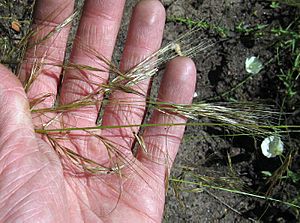Nassella lepida facts for kids
Quick facts for kids Nassella lepida |
|
|---|---|
 |
|
| Conservation status | |
| Scientific classification | |
| Genus: |
Nassella
|
| Species: |
lepida
|
| Synonyms | |
|
Stipa lepida |
|
Nassella lepida is a type of grass that grows in bunches. It is also known by many common names like foothill needlegrass or small-flowered needlegrass. Sometimes, plants have different scientific names over time. For this grass, Stipa lepida is an older name, or synonym.
Contents
Where This Grass Grows
This grass is native to California in the United States. This means it naturally grows there. You can find it in many parts of California, from Humboldt County in the north all the way down to Baja California in Mexico.
It likes to grow in certain places. These include chaparral areas, which are like shrublands. It also grows in open grasslands. You might also spot it in coastal sage scrub and coastal prairie areas near the ocean.
What Foothill Needlegrass Looks Like
This grass is a perennial, which means it lives for more than two years. It grows in clumps, like a small bush of grass. It can get quite tall, sometimes reaching up to one meter (about 3 feet) high.
Leaves and Flowers
The leaves of this grass can be flat or rolled up. They can grow up to 23 centimeters (about 9 inches) long.
The flowers of the grass grow on a special stalk called a panicle. This panicle can be very long, up to 55 centimeters (about 21 inches). It has many branches. Each branch holds small groups of flowers called spikelets. Each spikelet can have up to six tiny flowers.
A cool part of the spikelet is its long, thin bristle called an awn. This awn can be quite long, measuring about 4.6 to 5.5 centimeters (about 2 inches). It helps the seeds spread.
How Scientists Study This Grass
Scientists often study plants to understand them better. This grass, along with some others, used to be in a different group called Stipa. But recently, scientists moved them to the Nassella group. They did this because of a special feature of their seeds. The seed's outer layer, called a lemma, is strongly convolute. This means it's tightly rolled up. Genetic tests also showed that these grasses are more closely related to others in the Nassella group.
Sometimes, different types of grasses can mix their genes. This grass might even hybridize with another type of grass called Nassella pulchra. This means they can create a new plant that has features from both parent grasses.


